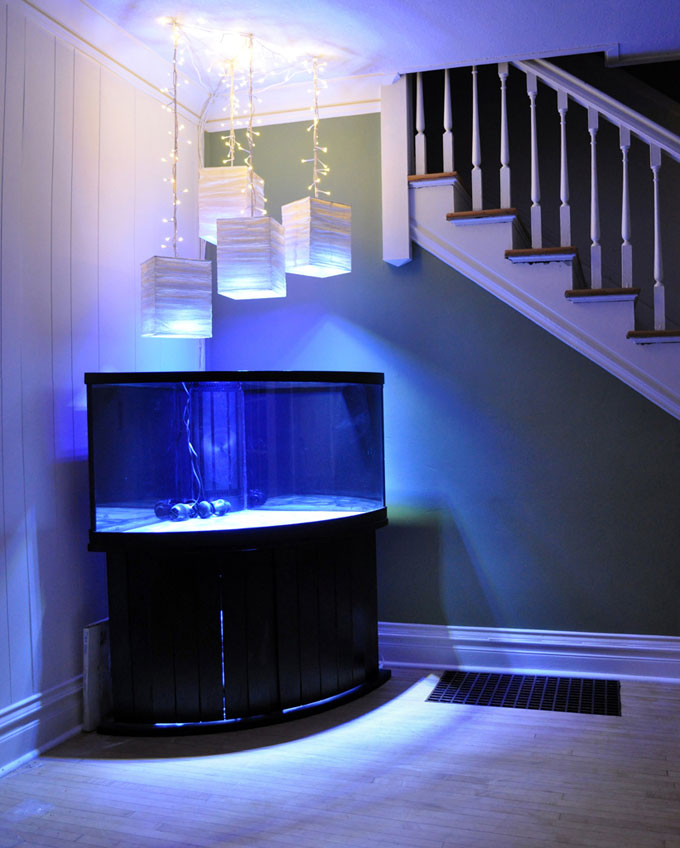PAR 38 LED bulbs designed with aquariums in mind have been around for a while now. I’m quite pleased with the results using the Ecoxotic Panorama LED Fixture in growing various corals, so the decision was made to ditch the hulking biosphere-looking 250 watt Lumenbright black pendent that was planned for a long running display tank project, and go another route.

This change of lights was LEDs or bust, because replacing an $80 metal halide bulb every nine months just gets expensive awfully quick. Ecoxotic’s PAR 38 LED spotlights got me thinking outside the pre-manufactured, one-design-and-one-style-fits-all box.
 After a lot of back and forth, I settled on a 4 bulb configuration for the 92 gallon quarter-circle corner tank in planning. The layout would use three of the 12K bulbs, and one Royal Blue bulb at 21 watts each and total of 84 watts consumed. At peak power this LED lighting setup consumes 60% less electricity than the previous 250 watt metal halide. Since this tank is not destined to showcase light hungry Acopora, I’m thinking this is going to work out just fine. Even if these 4 bulbs prove insufficient for my plans, there is still room to add supplemental lighting down the road. The PAR meter is on its way – you can bet I’ll take some measurements once this is up and running.
After a lot of back and forth, I settled on a 4 bulb configuration for the 92 gallon quarter-circle corner tank in planning. The layout would use three of the 12K bulbs, and one Royal Blue bulb at 21 watts each and total of 84 watts consumed. At peak power this LED lighting setup consumes 60% less electricity than the previous 250 watt metal halide. Since this tank is not destined to showcase light hungry Acopora, I’m thinking this is going to work out just fine. Even if these 4 bulbs prove insufficient for my plans, there is still room to add supplemental lighting down the road. The PAR meter is on its way – you can bet I’ll take some measurements once this is up and running.
What I’m really digging is the fact that a PAR 38 LED bulb uses a socket that is widely available and everyone should be familiar with – it’s no different than your standard incandescent light fixture. What does that mean? It means an extremely wide range of fixtures can be implemented to create a lightning design that is all your own, like nothing ever seen before. It makes your lightning an integral part of your overall tank design (if you want it to be) but also may allow for economical setup and wiring.

PAR 38 LED spotlights like these offer only a couple considerations. First, you need to get a fixture that can comfortably house the bulb. With a more “spotlight” shape and configuration, this will rule out some of the more stylish glass shade pendent options. That said, the largest diameter of the bulb is where the light is cast, measuring just around 4.75 inches in diameter. So if the opening is larger than that, and it doesn’t taper too quickly, you should have a fit. Since the light is not cast out in all directions, but more targeted downwards, you won’t get the full “glow” that you might with an incandescent or compact fluorescent bulb.

The final consideration for PAR 38 LED installations is one of air flow and heat dissipation. In talking about this plan with ReefBuilder’s Jake Adams, he expressed a need for venting at the top of a fixture to allow heated air to rise and escape. Conversely, in talking with Ecoxotic, they were not as concerned about LED performance being compromised due to heat being “trapped” by a fixture, and felt that an open bottom shade provided for sufficient passive cooling. Concerned either way? Even a slight fan breeze might be more than enough to get the job done.
In the end, after seriously weeks of looking at lights, I settled on Ikea-sourced paper shades with white cords (I did NOT want to run wiring through the walls and ceiling to hang pendents). These shades are open at the top, which allows for completely unrestricted air flow. How the paper, and the metal frames, will stand up to humidity remains to be seen (I’m leaning back towards a glass top to help reduce moisture issues).
In what can only be described as simply “being inspired”, I also found a strand of LED lights, something like Christmas lights but different, at Ikea. I used these lights to accent and at the same time distract from the cords, creating what I can only describe as a “starfield” of yellow-hued light pinpoints floating above the Ecoxotic PAR 38 LEDs. There’s MY take on moonlights.
Now you may think it looks great, or you may think it looks tacky – I’m no interior designer. But the one thing you can’t say is “Oh, my buddy has that light fixture over his tank”. That’s the beauty of considering PAR 38 LEDs for your next aquarium setup. They provide an easy manner in which to be creative with your aquarium, taking a moment to consider not only what’s going on inside, but how the aquarium itself plays a role in your overall space.
Obviously this is still an “air tank” for the time being, but “water breaking” is due for August. I look forward to showing you all how it worked out several months down the line. For now, let me close with an invitation – I’d love to see how ReefBuilders readers are using PAR 38 LEDs in their own aquariums. Share some links down there in the comments!





